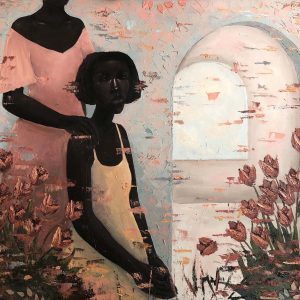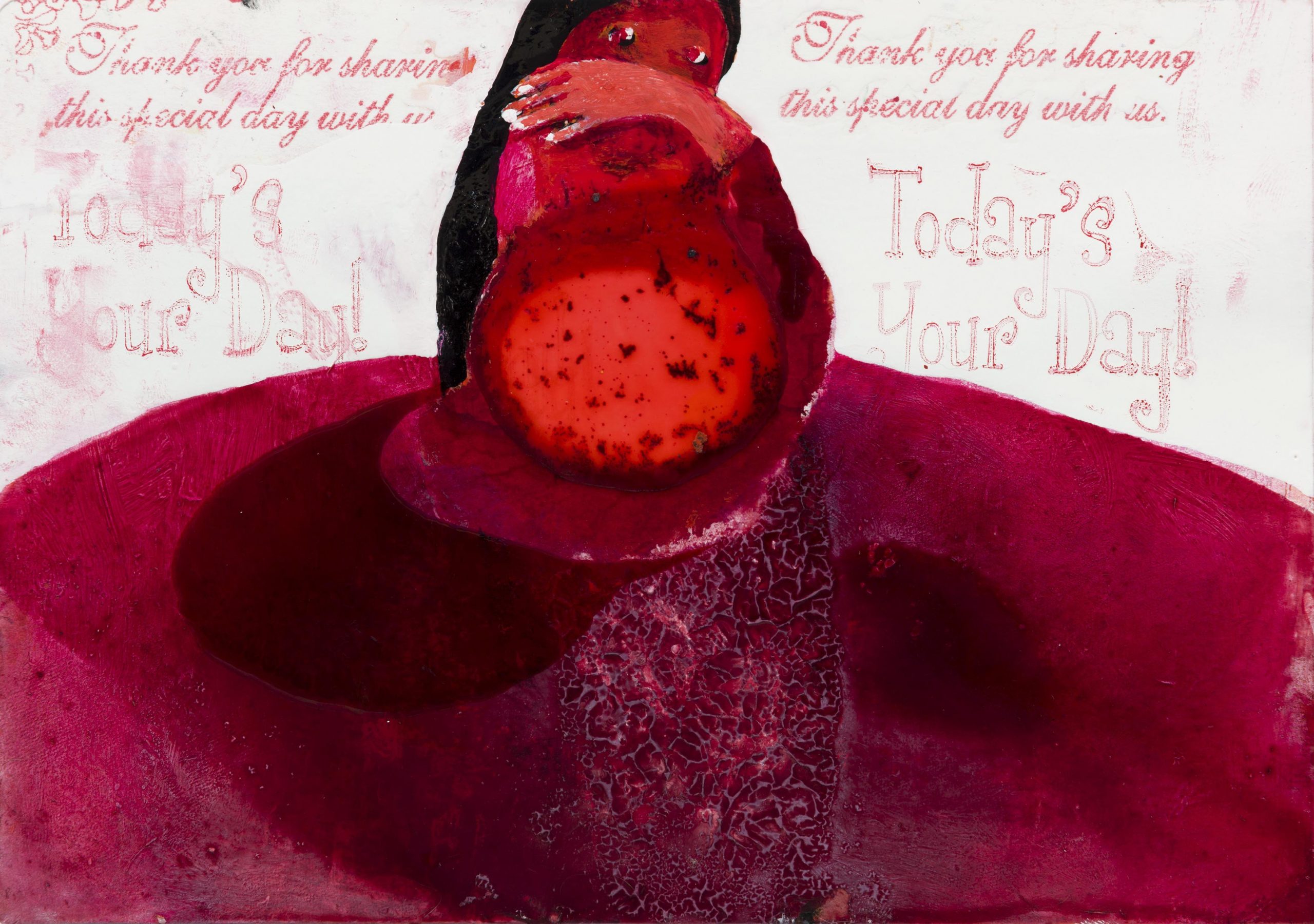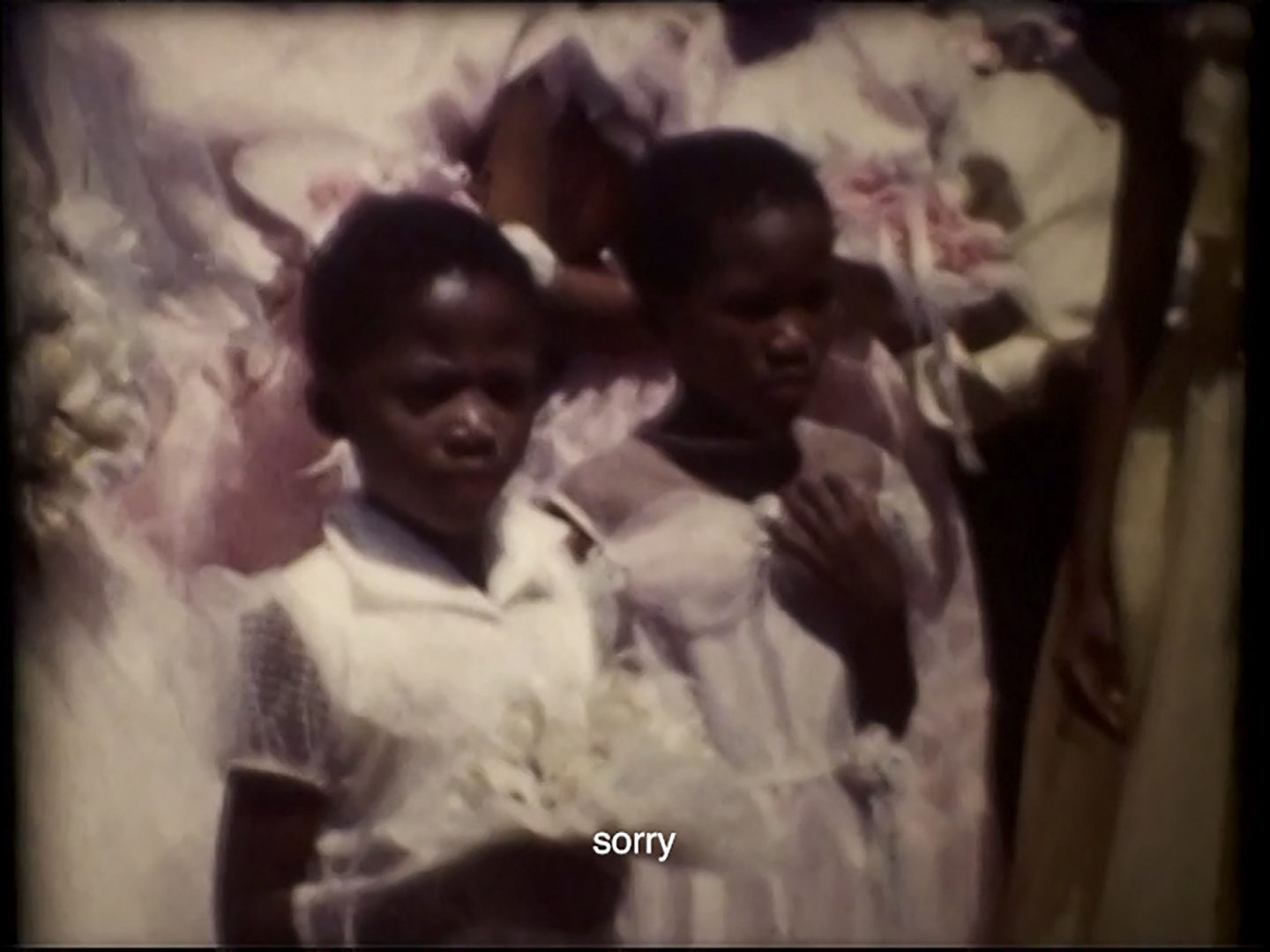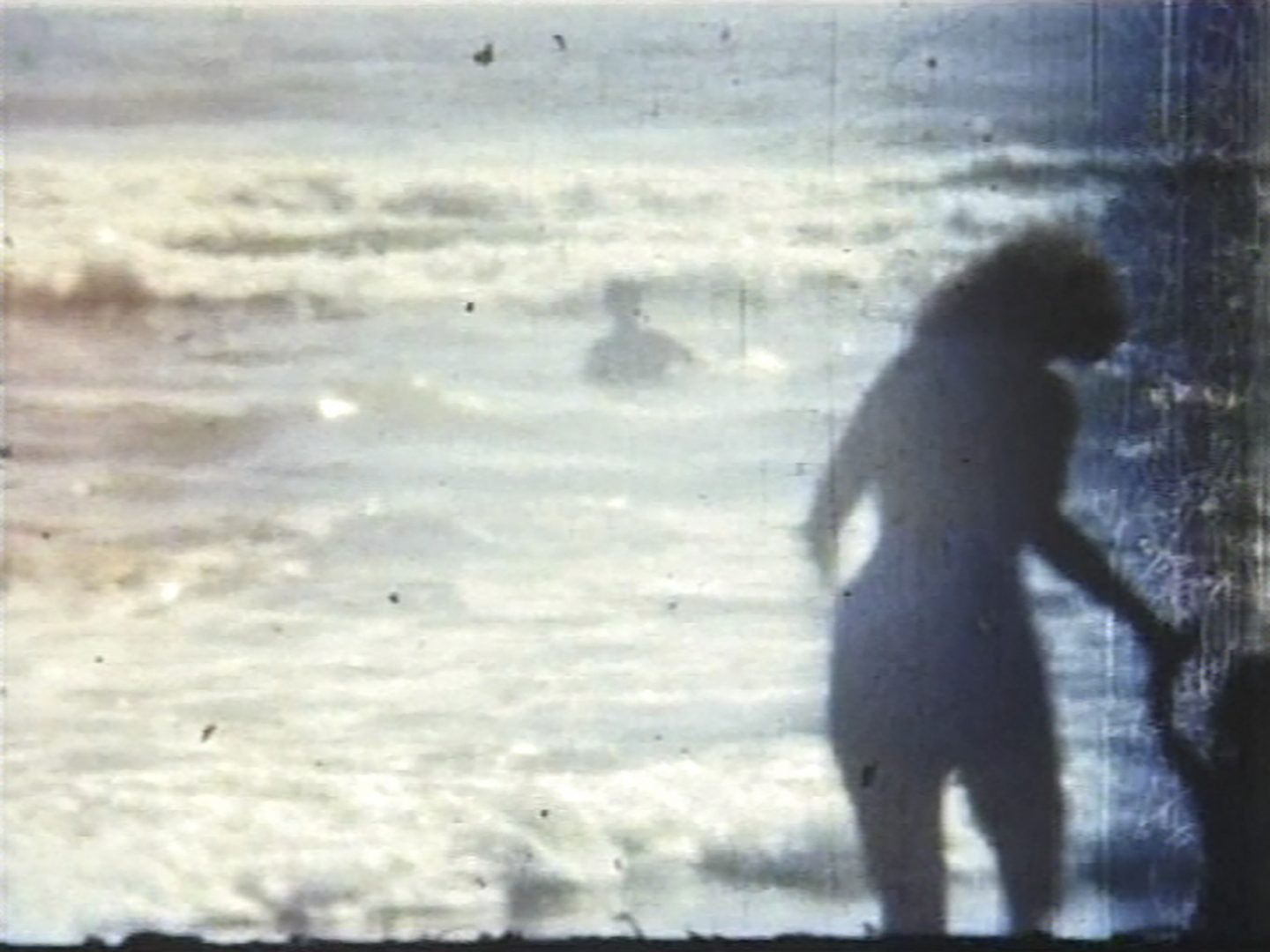Penny Siopis on confronting shame
Her paintings in the Shame series and a new short film invite introspection from the viewer on the feeling in its various forms and in sites not often associated with it.
Author:
26 March 2021
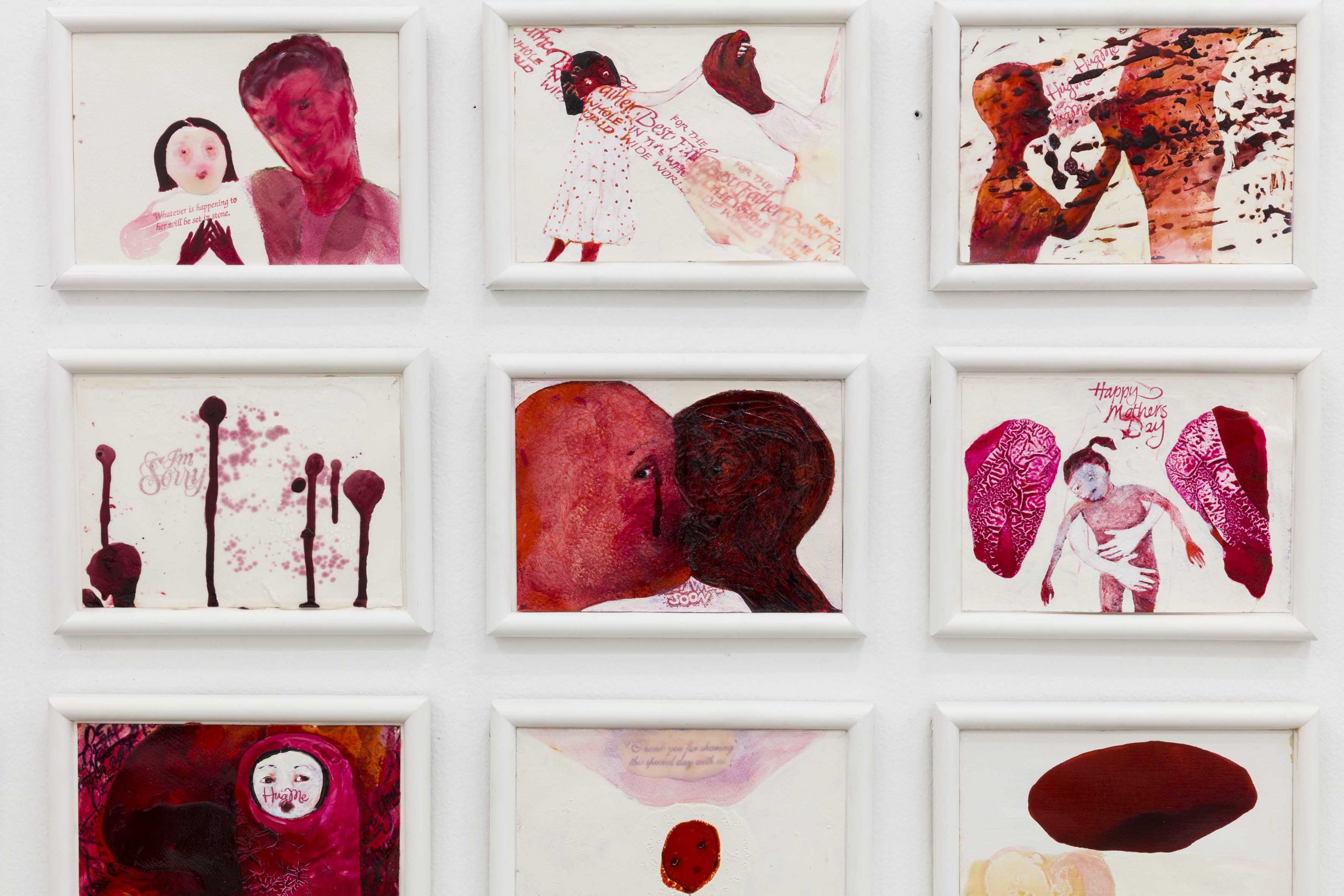
The first thing that strikes one about Penny Siopis’ series Shame is its scale: 165 paintings command the walls of the large Stevenson gallery room in Cape Town. In the artist’s signature reds, oranges and pinks, the individually framed paintings take up only a part of the wall space but they reconfigure one’s experience of the room.
Second, one is confronted by how small the individual paintings are, how very peculiar each one is – in the way that are unique and provoke a particular feeling. Perhaps this combination of how space is altered, and the paintings’ peculiarity is the work art always performs.
Related article:
Still, the frieze formed by the small, tile-size paintings is both a pattern five frames deep and a disruption. Sometimes, recognition is on offer. At other times, Siopis challenges one’s associations. Many times, it is impossible to name exactly what one sees. The individual paintings simulate tiles from a distance, but closer examination highlights their difference.
This is Siopis’ answer to: how does one tend to shame? It is a deceptively simple question because, as art historian Griselda Pollock has variously said, shame is both psychological and political. It is form and mobile. Specifically, in Siopis’ treatment, it is also historically constituted, inflected and reconstituted. And so, to take the images in, one walks along the wall, the body’s movement mimicking the timelines evoked through this sensory experience: from clarity to question, and image to movement.

Detailing shame
Inside each frame there is precision and the attention to detail one has come to expect from a painter of Siopis’ calibre. In one painting, a pink woman is in profile, her bob immaculately styled in a red so deep that it appears black. Each eyelash is carefully outlined and so are the white headband, dark red lipstick and perfectly arched brow, all of which give her distinction.
Above her, in less orderly cursive, is stamped “hush, little baby, don’t you cry”. Both the text and the image are familiar, reaching out to the worlds of women beyond the frame. The image simultaneously recalls women’s beauty and body styling and child rearing. There is shame here, too, if one looks closely.

In another painting, thematic links exist as echo. In this image, a large red blob dominates the frame with “hush” stamped on the bottom left edge. The red is darkest at the top of the page and lightest at the edges. It looks like blood spreading, a bleeding out, mobile, textual, bodily.
Siopis has used lacquer paint, which she describes as sticky and difficult to work with, as well as oil and enamel paints. In different images the three paints fight with each other, and sometimes one wins to achieve a glue-like transparency. At other times, the surfaces are distressed, ridged, or congeal. There is a folding here and there, reminiscent of a blood clot or a flooding of the frame. Siopis tells Pollock and writer Sinazo Chiya, who is also the Stevenson’s press officer, that this “broken, ruptured surface” is a “way to materialise shame”.
Each image is stamped: “I’m sorry”; “Thank you for sharing our special day with us”; “Home is where your mom is”; “Forgive if you hope to be forgiven”; “What a star”. And on it goes. The image and text are juxtaposed, competing and complicating, and the tension is illuminating.

Roots of shame
Siopis worked on Shame between 2002 and 2005, reflecting on the work of the Truth and Reconciliation Commission (TRC) in South Africa. It was a response to the large-scale witnessing of apartheid history, shame at being white and at the scale of the crime, not as surprise but as confrontation. She exhibited the series as Three Essays on Shame as part of another historical moment – the centenary of Freud’s Three Essays on Sexuality at the Freud Museum in London, England, in 2005.
The series points to the affective and political dimensions of shame as well as its possibilities. While Siopis explores shame as a product of racial and sexual violence, it is important to note that shame inheres in many experiences of girlhood that would not conventionally be seen as sites of violation. The TRC-induced shame at white identity meets a pre-existing shame on a woman artist whose body is also a site of shame.
Whereas violence produces shame, Siopis’ imagery and arrangements also remind one that sexual violation meets pre-existing shame for girls and women. Indeed, this is what the leaking, bloody, unspecific images gesture towards – a significant part of the socialisation of girls, from menstruation and self-regulation to industries designed to rein in the excessive female body.
Consequently, shame is about embodiment under oppressive systems as well as explicit violence. Shame is a deeply personal psychic experience as much as it is relational. As Pollock suggests in her broadcast Zoom conversation with Siopis, this portrayal of shame in the series and film is also an invitation to bear witness.
Revisiting shame
Siopis revisists shame in 2021 with a six-minute film commissioned by the Peltz Gallery in London and Birbeck, a constituent college of the University of London. Shadow Shame Again is dedicated to Tshegofatso Pule, a young, pregnant woman who was murdered and whose body was found hanging from a tree in June 2020 during the Covid-19 lockdown.
Made from digitally manipulated 6mm and 18mm film reels, some found and some shot by the artist’s mother, the film extends Siopis’ historical engagements with shame. Chiya says that in juxtaposing imagery of working hands, weaving or sculpting or playing, with celebratory rituals such as a wedding or a dance recital from the 1950s and 1960s along with a capella singing, the film takes on an urgency that renders wounds and the rituals of how women are subjugated visible.
Shadow Shame Again opens with a red curtain that visually links to the reds in the Shame paintings. Siopis reveals that this footage is from a Passion Play. It is followed by a quotation from my 2015 book, Rape: A South African Nightmare, in which I point to the systemic nature and everywhereness of patriarchal violence. Mine is an argument against prioritising the language of the spectacularly visible when addressing patriarchal violence in favour of seeing that rape, femicide and other forms of violence are imprinted in the ordinary fabric of life and on bodies that do not immediately suggest violence.
Related article:
In the film, Siopis highlights three other historical framings of shame: Covid-19 as a pandemic, violence against women as another, and shame. Shame reaches across time. It is in the fragments evoked in the specificity of her paintings and the slivers and holes in the film, all of which stand for what Siopis reminds us is shame’s “systematicness”.
The footage, music and clapping in the film, like the careful paintings arranged as a frieze, create meaning together about violence’s production of shame, and about its raced, gendered and historically contingent meanings.
Tending to shame
So, what does it mean to tend to shame? For Siopis, it is to highlight its birthplaces as well as its possibilities. After all, shame may be a constant political and personal haunting, but its relational textures enable the possibility of empathy and transformation.
To tend to shame, Siopis suggests in stylised, leaking and interrupted visual languages, is only possible through mobility. Witnessing, empathy and transformation open up only outside of what Pollock calls “typical cinematic logics”, and Siopis reminds us that in “putting together things from fragments”, we recognise “that they are fragments” of a larger and more complex consideration of shame in our society.

The Shame series and Shadow Shame Again are on show at the Stevenson gallery in Cape Town as part of Art Basel Online Viewing Room: Pioneers, which runs from 24 to 27 March.

